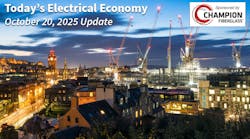Trump Election Leaves Mostly Questions About Electrical Industry Policy Prospects
With the Republican party winning control of the White House, Congress and many state governments last week after a divisive election campaign, the electrical industry’s political experts now find themselves in the position of having to build new policy plans in a distinctly unpredictable environment. The election of Donald Trump defied expectations.
“I was utterly and completely wrong about this election,” Ed Orlet, senior director of Development & Government Affairs for the National Association of Electrical Distributors (NAED), said in a post-election update on NAED PAC’s YouTube channel. “Most people got it badly, badly wrong. Polling is dead. Punditry is dead. And Trump is president.”
The first question facing electrical industry political operatives is how to plan. Do they orient toward policy statements Trump made on the campaign trail or toward more traditionally Republican priorities?
“We can’t assume Trump will work hand in glove with a Republican congress,” Orlet said in the video, but added that the NAED PAC’s priorities continue. “We’ll be working to protect LIFO and eliminate the death tax,” he said. “Republicans owe us a vote on marketplace fairness. We’ve been very patient.”
Most of the organizations that represent the electrical industry expect the change of leadership to be overall positive for the industry, particularly if Congress and the Trump administration follow through on promises to lower taxes and reduce the regulatory burden on businesses.
Infrastructure spending and a roll-back of restrictions on the energy sector emerged as an important themes during the campaign. This was reflected in the post-election stock market reaction where construction and fossil fuel related companies and commodities rose while renewables fell. At this week’s annual meeting of the National Electrical Manufacturers Association (NEMA) the prospect of greater investment in infrastructure was seen as a potential boost to the electrical industry.
Trade restrictions could complicate things for electrical manufacturers active international markets and distributors selling imported lines, but it’s unclear what the implications would be for the profitability of global supply chains or for growth in global trade.
The National Association of Home Builders (NAHB) issued a post-election statement that any policy changes that restrict trade will act as a drag on economic growth and warning that “if policy changes result in a growing deficit or overheating labor markets, interest rates will rise (faster) in response,” which would create headwinds for housing affordability.
IHS Markit, in its analysis of the results, considered the possibility that President Obama, in the final months of his administration, may pursue additional executive actions around the environment, immigration, and relations with Cuba, while Trump in his plans for the first 100 days of his administration will look to undo many of Obama’s legacy domestic policies, which “could include driving growth to the energy sector by removing barriers to projects imposed during the Obama administration.” The analysts at IHS also expect an economic boost from Trump’s flagship tax reform proposals.
The National Electrical Contractors Association (NECA) urged action on key initiatives before the end of the year, including multi-employer pension reform, repeal of the Cadillac tax, comprehensive energy policy legislation and energy tax credit extensions.


